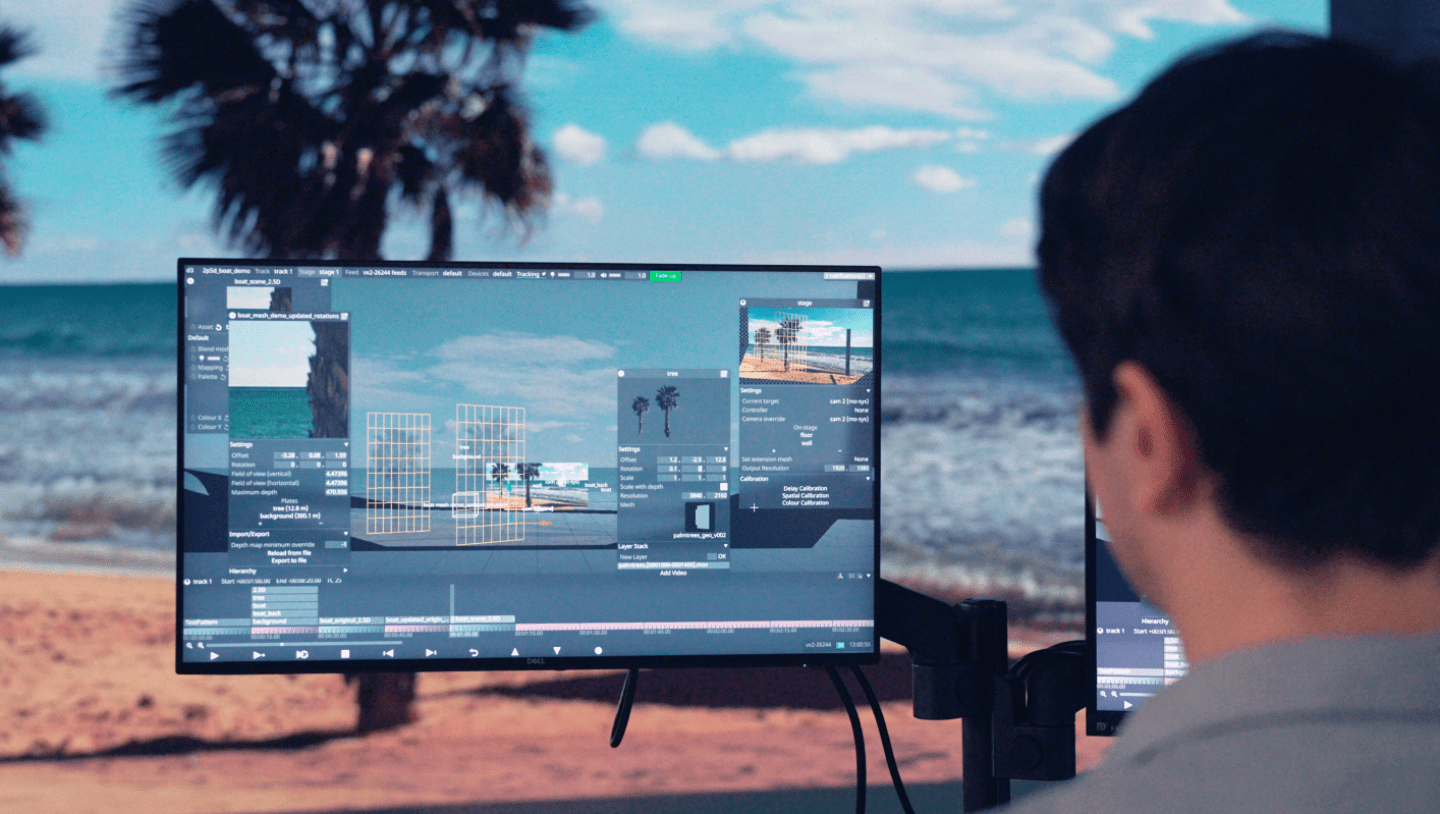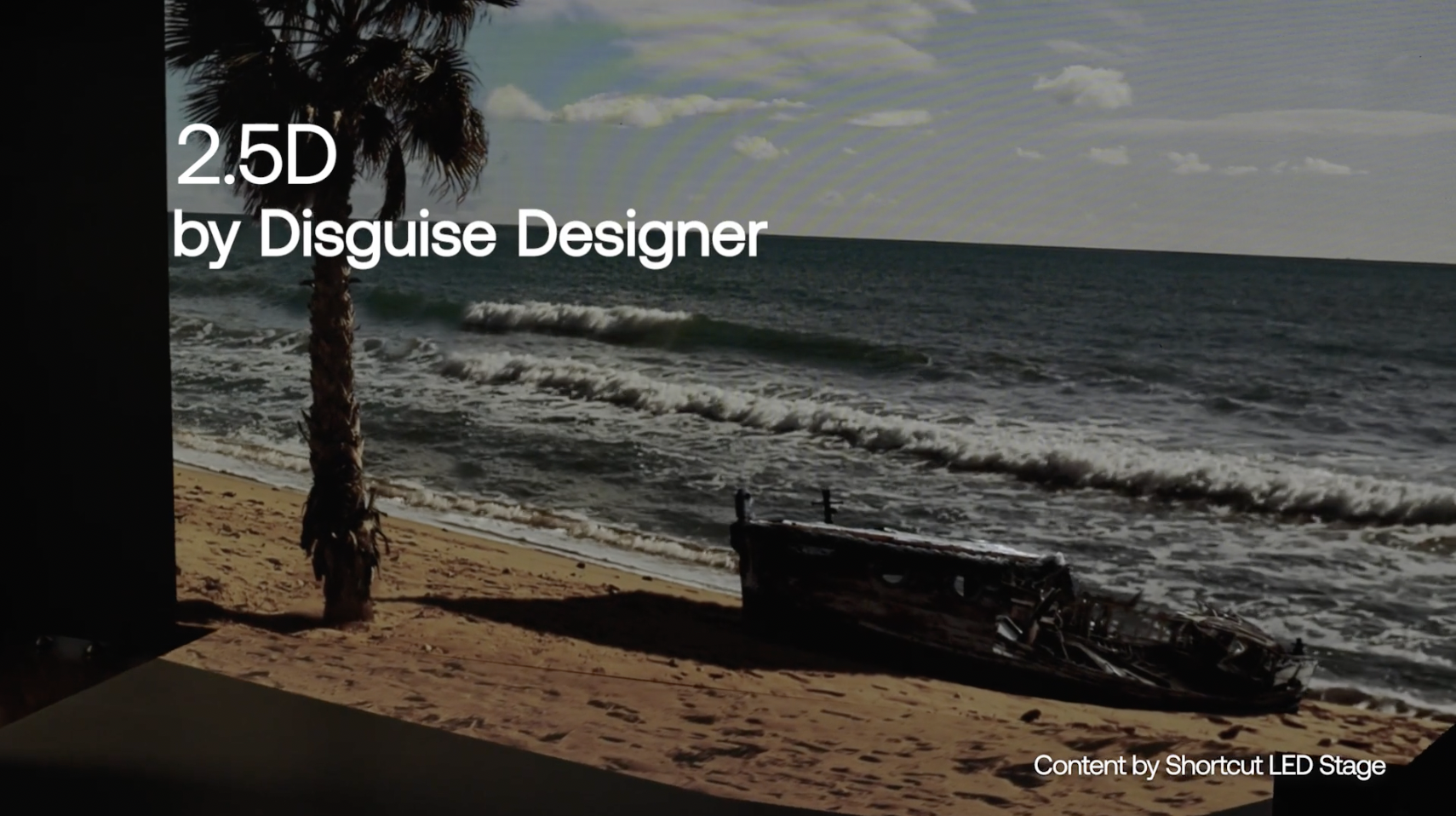Exploring 2.5D workflows
Offering the flexibility of 3D workflows combined with the simplicity of 2D, 2.5D workflows are changing the world of virtual production.
Virtual Production

Virtual production has broadened the horizon for filmmakers. Within that, there are many different workflows available. Offering the flexibility of 3D workflows combined with the simplicity of 2D, 2.5D workflows are fast becoming a favourable choice for filmmakers. At Disguise we have advanced our Designer software to make 2.5D easier than ever before.
What are 2D workflows?
2D workflows consist of plates, created with on-site photography or videography and assembled in tools like Photoshop, After Effects, and Adobe Premiere. They are delivered as backdrops on virtual production panels.
2D is most often used for compositions with distant backgrounds or window plates in car shoots. Commercials and music videos which have a tight budget are most likely to use 2D.
2D workflows offer limited depth with no parallax effect, limit camera movements and leave no way to make iterative changes on set.
What are 3D workflows?
3D workflows is what virtual production is famous for - the expansive, immersive world seen in Star Wars: The Mandalorian and other major films. They require real-time content built in Unreal Engine, Notch and Unity. As the graphics can be updated as the camera moves, an immersive film set is created with the ability to achieve the parallax effect, move the camera in any direction as well as make iterative changes on set.
Although incredible to use, 3D is time and budget-intensive, requiring special teams of virtual content artists to create the scenes and assets in the render engine. This approach is not always feasible within the timeframes and budget constraints many filmmakers have to operate within.
Benefits of 2.5D workflows
2.5D is the middle ground between the ideal and the reality. Offering the ability to achieve the parallax effect, 2.5D offers the perfect solution for scenes that have a few small camera movements, demand a bit of depth and no sacrifice to photorealism.
Through creating an illusion of depth through the use of layered plates, they offer new opportunities for filmmakers. Without having to spend lengthy preproduction time building 3D assets or paying for Virtual Art Departments (VAD), productions of all sizes can benefit from virtual production without the budget-crunch.
There are also opportunities for productions operating on tight budgets and timescales, such as commercials and music videos, to create more immersive worlds that would previously have been out of reach.
2.5D workflows represent, above all else, an expansion to the flexibility virtual production already offers projects. It is a nuanced tool that brings added depth to the screen and simplifies the process of creating a believable environment with a mid-ground that feels distinct from the background.
Disguise Designer enhances its 2.5D workflow
Working within Disguise’s Designer software, production teams have an accessible tool to build and compose multi-layered 2.5D backgrounds that will appear seamless onscreen and be fully customisable in advance of filming, allowing teams to previsualize their work and deliver it with ease.
The process of creating this 2.5D empowered set is simple within Designer. Having created a simple stage with an LED surface and a camera, users create a 2.5D layer and a 2.5D asset which contains a number of plates. As well as a background, users typically include a number of other levels to represent different areas in the mid- and foreground. The more layers included, the more realistic the parallax effect.
The end result is a number of different plates that each represent background features that sit at varying distances from the camera - a city skyline in the distance, with shoreline buildings ahead of them. When the camera moves, the Designer software can adjust these plates accordingly.
Disguise’s compatibility with real time content generation tools like Notch can create added realism within layers, too. Simple animations can be added, bringing subtle rippling movement to plates featuring water, for example. The result is an extra element that builds upon the nuanced impact of a layered 2.5D background.
Supercharge your virtual production workflow
Disguise has now improved usability of the 2.5D workflows in Designer - users achieve the same results in fewer clicks enabling easier integration with 2.5D content creation workflows and 2.5D scenes. You can easily adjust settings for the 2.5D asset as a whole such as rotating all the plates in one go, and easily adjust plate depth with auto-scaling, using the plate editor or in the visualizer. Plates can be flat, or be given shape by assigning a 3D mesh to the plate or using depth data created in external tools.
You can import 2.5D scenes from content creation tools such as Cuebric, and export your 2.5D scene from Designer which you may have composed there from scratch so you can easily reuse it in other projects.
Learn more about Cuebric
When to use 2.5D vs 2D or 3D
2.5D technology represents a significant new addition to the virtual production toolbox, but its value lies in the smart application of all that it offers. It’s important to consider how 2.5D can elevate your production, and whether your work might be better served by 2D or 3D approaches.
The success of 2.5D comes down to the seamless integration of the different layers that comprise the backdrop. This means that both pre-production and on-site processes can be slower than when using simple 2D backgrounds. It is worth ensuring you have the time and talent to invest in ensuring the final product lives up to its potential.
Overall, 2.5D workflows can be significantly more cost effective than creating full 3D backgrounds, and bring invaluable depth to scenes that need more than straight-forward 2D scenery. With the intuitive flexibility of Disguise’s Designer software, a 2.5D workflow that delivers exactly what your production needs is more achievable than ever before.
